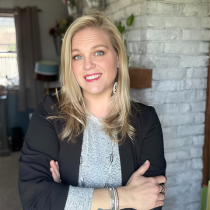Caregivers are asked to do everything. At work, they are expected to work like they are family-less. At home, they are expected to care as if they were jobless. The result is an impossible balancing act that makes too many burn out, go unrecognized, and feel unsupported.
True balance is not doing nothing but protecting yourself while you are caring for other individuals. And that’s not keeping your workplaces and your communities from regarding caregivers as machines but as human individuals.
To discuss assisting caregivers with establishing boundaries, accessing resources, and utilizing end-of-life care tools for their protection, we chatted with Kacie Gikonyo, RN — aka Death Doula Kacie. She’s the founder of Death Doula School and The Death Doula Collective and a leading spokesperson for caregivers and end-of-life education.
Caregivers are asked to give 100% at work as if they do not have a family, and 100% at home as if they do not have a career. It’s incessant. Society asks for everything but provides very little in response. Caregivers are treated as if they do not exist when actually they bear two full-time responsibilities. The issue is not merely balance, but surviving for acknowledgment, respect, and resources that rightfully belong.
Boundaries will have to be consistent. Caregivers will have to establish hard limits with their workplace at an early stage, like employers do. Be direct and unremorseful about proclaiming limits. When limits change, they will not be respected. Self-care is not selfish – it’s the only method of sustaining work and caregiving while remaining uncompromising.
Time management is not doing more of everything today — it’s the protection of your energy. Self-care must be scheduled like appointments. Be priorities-forward, realistic goal-setters, and become comfortable saying no. Time blocking, passing tasks on, and using your support systems establish a routine. Efficiency is doing those things that matter, not those that do not.
– Kacie Gikonyo
Not a single caregiver will do it by themselves. Support groups from your locality, online chat groups, and professional groups will offer direction as well as encouragement. Caregivers will need to ask their families, their friends, and their coworkers for help and be very direct about their needs. Most businesses also offer help, programs of mentoring, and local programs of caregiving. The best caregivers are not the ones who do everything by themselves but also know whom they need to rely on.
Self-care is everything. You cannot pour from an empty cup. Too many wait until burnout before they take care of themselves — but that’s backward. Self-care needs to be booked with an apology, not because of burnout, but because of prevention. When caregivers prioritize rest, joy, and well-being, they do more than take care of themselves better — they show up stronger for others, too.
Few employers are very empathetic. They assume that their workers will work like they have no caregiving responsibilities at home, but that’s not possible. Good employers regard their workers as human beings first. They make policies flexible: options for work from home, family leave, schedule adjustment, and an environment that cherishes balance. Support of that sort involves giving staff permission to care for both work and family at no personal cost.
Technology is a lifesaver. Scheduling programs and internet calendars keeps caregiving, work, and self-care on schedule. Task management programs prioritize that which is urgent over that which is not. Telemedicine decreases trips for appointments, and meal delivery or smart home appliances decrease daily stress. Incorporating tech to streamline, not complicate, is the idea — caregivers have enough on their plate.
Kacie’s words that come home are an essential lesson: caregivers do not have to do everything. They require balance, boundaries, and backup — from themselves, their communities, and their employers.
It starts with recognition: caregivers are not machines. Routine self-care, established limits, and open access to support networks enable caregiving. And when employers use caring policies, they create work environments in which individuals are able to succeed in two roles — as professionals and caregivers.

Darla Kacie (Death Doula Kacie) Gikonyo is an RN, Death Doula, educator, and Death Doula School founder -- the globe's most extensive death doula training program. She also established The Death Doula Collective, a national collective of doulas who network for peer support. Kacie decreases death fear, speaks out for caregivers, and trains professionals to add compassion and dignity at every step of life.